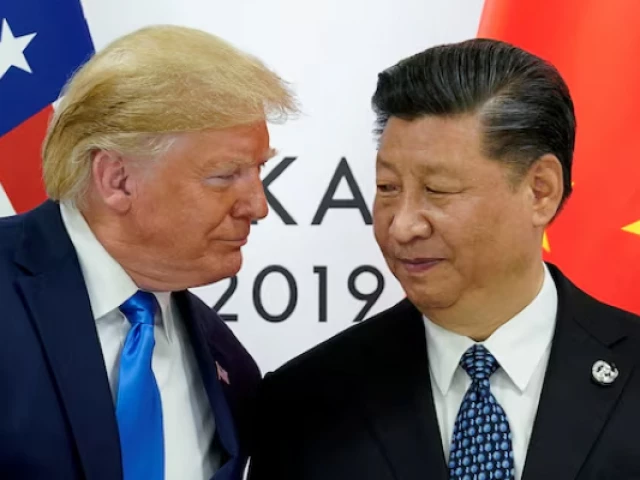Trump and Xi hold rare call as trade tensions and Taiwan concerns escalate
Trump says he respects Xi, values US-China ties, supports one-China policy, and hopes for strong Chinese economy

US President Donald Trump and Chinese leader Xi Jinping confronted weeks of brewing trade tensions and a battle over critical minerals in a rare leader-to-leader call on Thursday that left key issues to further talks.
During the more than one-hour-long call, Xi told Trump to back down from trade measures that roiled the global economy and warned him against threatening steps on Taiwan, according to a Chinese government summary.
But Trump said on social media that the talks focused primarily on trade led to "a very positive conclusion," announcing further lower-level US-China discussions, and that "there should no longer be any questions respecting the complexity of Rare Earth products."
He later told reporters: "We're in very good shape with China and the trade deal."
The leaders also invited each other to visit their respective countries.
The highly anticipated call came in the middle of a dispute between Washington and Beijing in recent weeks over "rare earths" minerals that threatened to tear up a fragile truce in the trade war between the two biggest economies. It was not clear from either countries' statements that the issue had been resolved.
A US delegation led by Treasury Secretary Scott Bessent, Commerce Secretary Howard Lutnick and Trade Representative Jamieson Greer will meet with their Chinese counterparts "shortly at a location to be determined," Trump said on social media.
The countries struck a 90-day deal on May 12 to roll back some of the triple-digit, tit-for-tat tariffs they had placed on each other since Trump's January inauguration.
Though stocks rallied, the temporary deal did not address broader concerns that strain the bilateral relationship, from the illicit fentanyl trade to the status of democratically governed Taiwan and U.S. complaints about China's state-dominated, export-driven economic model.
Since returning to the White House in January, Trump has repeatedly threatened an array of punitive measures on trading partners, only to revoke some of them at the last minute. The on-again, off-again approach has baffled world leaders and spooked business executives.
Major US stock indexes were higher on Thursday.
China's decision in April to suspend exports of a wide range of critical minerals and magnets continues to disrupt supplies needed by automakers, computer chip manufacturers and military contractors around the world.
Beijing sees mineral exports as a source of leverage - halting those exports could put domestic political pressure on the Republican US president if economic growth sags because companies cannot make mineral-powered products.
The 90-day deal to roll back tariffs and trade restrictions is tenuous. Trump has accused China of violating the agreement and has ordered curbs on chip-design software and other shipments to China. Beijing rejected the claim and threatened counter-measures.
"The US side should take a realistic view of the progress made and withdraw the negative measures imposed on China," the Chinese government said in a statement summarizing Xi's call with Trump published by the state-run Xinhua news agency
In recent years, the United States has identified China as its top geopolitical rival and the only country in the world able to challenge the US economically and militarily.
Despite this and repeated tariff announcements, Trump has spoken admiringly of Xi, including of the Chinese leader's toughness and ability to stay in power without the term limits imposed on US presidents.
Trump has long pushed for a call or a meeting with Xi, but China has rejected that as not in keeping with its traditional approach of working out agreement details before the leaders talk.
The US president and his aides see leader-to-leader talks as vital to sort through log-jams that have vexed lower-level officials in difficult negotiations.
Thursday's call came at Trump's request, China said.
According to a press release by the Foreign Ministry of China, President Xi emphasized that the United States must handle the Taiwan question with prudence, so that the fringe separatists bent on “Taiwan independence” will not be able to drag China and America into the dangerous terrain of confrontation and even conflict.
President Trump said that he has great respect for President Xi, and the US-China relationship is very important. The US wants the Chinese economy to do very well. The US and China working together can get a lot of great things done. The US will honor the One-China policy. The meeting in Geneva was very successful, and produced a good deal. The US will work with China to execute the deal. The US loves to have Chinese students coming to study in America.
President Xi welcomed President Trump to visit China again, for which President Trump expressed heartfelt appreciation.
It's not clear when the two men last spoke.
Both sides said they spoke on Jan. 17, days before Trump's inauguration and Trump has repeatedly said that he had spoken to Xi since taking office on Jan. 20. He has declined to say when any call took place or to give details of their conversation. China had said that the two leaders had not had any recent phone calls.
The talks are being closely watched by investors worried that a chaotic trade war could disrupt supply chains in the key months before the Christmas holiday shopping season. Trump's tariffs are the subject of ongoing litigation in US courts.
Trump has met Xi on several occasions, including exchange visits in 2017, but they have not met face to face since 2019 talks in Osaka, Japan.



















COMMENTS
Comments are moderated and generally will be posted if they are on-topic and not abusive.
For more information, please see our Comments FAQ